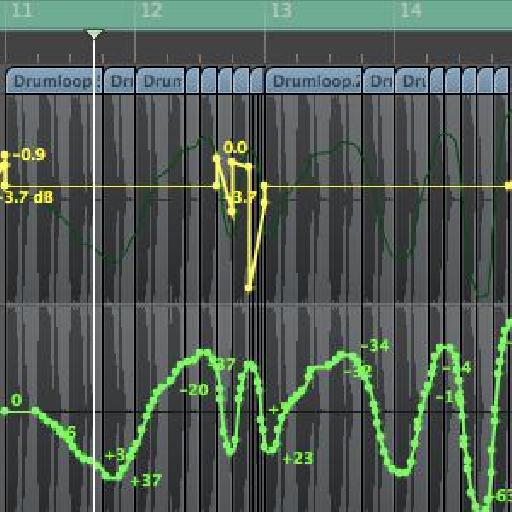اتوماسیون است که به معنای واقعی کلمه یکی از بهترین چیزها در مورد نرم افزار موسیقی تولید مدرن. امیدوارم من را صدا نیست که من می گویم که من به وضوح می توانید به یاد داشته باشید با استفاده از سیستم های که تا به حال صفر اتوماسیون و یا پاسخ به تماس و آن بود ، به خوبی... یک کابوس!
Now we can record, automate and edit any movements we make on just about any parameter in our DAW. This is truly a great thing but there are a few pitfalls that you have to look out for. Here we take a look at understanding the various automation modes in Logic Pro.
نوشتن اتوماسیون
وقتی نوشتن اولین داده های اتوماسیون خود را به یک آهنگ تازه ضبط شده یا برنامه ریزی شده ، شما می توانید هر یک از حالت های اتوماسیون سه (نوشتن ، محکم نگاه داشتن و لمس) استفاده کنید. هر یک از این حالت خوشبختانه جنبش خود را به مسیر اتوماسیون مناسب ضبط.
بنابراین بازی کردن پروژه خود ، به حالت نوشتن و شروع به حرکت سطوح ، تابه و پلاگین ها در پارامترهای. هنگامی که شما انجام می شود پیدا خواهید کرد که همه چیز ثبت شده است و آن را آماده استفاده است.
چرا استفاده از حالت چفت انتظار : کاهش از نوشتن؟
پس چرا پس از آن ، به شما بخواهید ، تا به منطق سه حالت های نوشتن و هنگامی که از آنها استفاده می کنیم؟ خوب ، حالت چفت یکی از مفید ترین حالت آن را به عنوان ادامه ضبط داده ها اتوماسیون زمانی که منطق در حال پخش است و شما به پایان رسید حرکت پارامتر / fader . همچنین بیش از هر گونه اطلاعات اتوماسیون موجود نمی نوشتن تا پس از یک پارامتر با کنترلر یا ماوس خود را حرکت شما .
نوشتن حالت مخرب به طور کلی باید مثل طاعون اجتناب شود.
این کار نوشتن داده های اتوماسیون در مفهوم سنتی ، اما هر چیز دیگری شده است که در تمامی track های ثبت شده را پاک کردن. دولت حتی اپل در راهنمای خود را که شما به آن نیاز دارند به ندرت و که "آن است که تنها وجود دارد برای تکمیل حالت های اتوماسیون .
حالت لمسی چیست؟
حالت لمسی حالت واقعا قابل استفاده است و بسیار شبیه به لچ حالت در آن است که غیر مخرب و برگ اطلاعات ثبت شده شما دست نخورده وقتی که پارامتر در سوال تنظیم است.

نکته سردبیر : حالت لمسی اساسا کار می کند مثل دفعات بازدید : حالت است . تا شما را تغییر پارامتر را با کنترل کننده لمسی و یا ماوس خود را ، با همه داده های موجود اتوماسیون خواهد شد خوانده. هنگامی که شما را آزاد دکمه ماوس یا کنترل کننده داده های موجود در اتوماسیون خواهد بود خواندن.
حالت لمسی بزرگ است اگر ، به عنوان مثال ، شما می خواهید به طور خودکار حجم فقط در بخش گروه کر... سپس در اسرع وقت شما آزاد دوره سطح fader ، fader خواهد انتخاب به هر مقدار موجود بود قبل از اینکه شما شروع به استفاده از اتوماسیون .
پخش چیزهایی برگشت
هنگامی که شما ثبت اتوماسیون بازی آن را به عقب به عنوان ساده به عنوان قرار دادن آهنگ به حالت 'خوانده شده '. هر چیزی را ثبت خواهد شد و سپس پخش شده به عنوان پروژه خود را می کند. ساده.
البته این ارزش به خاطر سپردن که هنگامی که در حالت لچ یا لمس کردن اطلاعات خود را نیز پخش ، بنابراین این هنوز دلیل دیگری برای استفاده از این حالت ها را بیش از نوشتن حالت اضافی است.

منطق 101 : منطق هسته 9 خودآموز برای راهنمایی های بیشتر اتوماسیون و ترفندها و وبلاگ این آموزش را برای کاربر 5 اتوماسیون توان نکته ها و ترفندها در منطق طرفدار !







 © 2024 Ask.Audio
A NonLinear Educating Company
© 2024 Ask.Audio
A NonLinear Educating Company
Discussion
Thanks
'Write' mode is great to use when you're 'recording' automation to a track for the first time.
Also, if you decide you wish to delete / overwrite all automation on all tracks... then use write mode! (It's safe to say I don't use write mode much!!)
I've been using logic through college for the past year but there's so much to learn!
Need to set aside more time for these tutorials me thinks!
@ Mo... I should've said "I don't use write mode EVER!!" Ha! Well, I'm sure I used it the once when I first used track automation in Logic and to my dismay the rest of the automation on my tracks disappeared ;-)
For example, I automate a track to go up in volume that orignally started on -5. But then I decide to move the fader down to -8. But when I try that, the automation automatically snaps back to -5 every time. Thanks!
Want to join the discussion?
Create an account or login to get started!